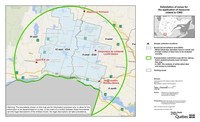Chronic wasting disease in cervids - The MFFP continues efforts to prevent the establishment of the disease in Québec and reminds the public of the measures to be followed Français
QUÉBEC, Sept. 14, 2021 /CNW/ - The ministère des Forêts, de la Faune et des Parcs (MFFP) maintains its enhanced surveillance of chronic wasting disease (CWD) in the area surrounding the farm in the Laurentides where cases were detected in 2018. Regulations regarding mandatory sampling and the transportation of some parts of cervids remain in effect in some areas of the Laurentides, Outaouais and Montérégie regions (see map below for CWD measures application areas).
Mandatory sampling
A hunter who harvests a white-tailed deer or a moose over 12 months old within a 45 km radius from the farm where CWD was detected in 2018 must have the game tested for this disease. The hunter must go to one of the designated registration stations within the 45 km radius in order for MFFP staff to collect the required samples. Contact information and hours of operation are available on the page List of registration stations [in French only].
Elsewhere in Québec, the MFFP will carry out analyses on harvested white-tailed deer through a partnership with some butcher shops.
Analysis results will be available online at Québec.ca/cervidsdisease.
Transportation restrictions of some anatomical parts of cervids
Some parts (including the head and the spine) of white-tailed deer, moose or farmed cervids harvested less than 45 km away from where CWD was detected in 2018 must not leave the area delineated by this radius. Those parts must also stay within the hunting zone in which the animal was harvested. Thus, even if it is possible to register these types of game online, the butchering must always be done within the 45 km radius and the hunting zone in which the animal was harvested. The purpose of these transportation restrictions is to avoid the spread of the disease to other regions of Québec.
The MFFP encourages hunters to practice their activities in a responsible manner and in accordance with safety rules and regulations. Finally, the owner's authorization is required to hunt on private land.
Antlerless deer hunting licences usable in some parts of hunting zones 9 west and 10 east
In order to temporarily maintain lower deer density near the location where CWD cases were detected in 2018, antlerless deer hunting licences were allocated for this area. The licences that were issued specifically for the enhanced surveillance area (ESA) are not valid for the entire hunting zone, but only in the part included in the ESA (9 west-ESA or 10 east-ESA). The maintenance of lower deer density aims at reducing contact between wild animals and thus limit the spread of the disease if an infected animal is present in the wild.
Since antlerless deer hunting licences were also allocated for parts of the hunting zones 9 west and 10 east that are outside of the ESA, it is important to use the special licence only in the part of the zone where it applies.
Publication of the Plan to fight CWD
In light of the experiences associated with the 2018 outbreak, the MFFP recently updated its plan to fight CWD. The objective of the plan is to protect Québec's wild and farmed cervid populations and, by extension, the economic activities related to them.
The purpose of publishing this plan is to inform all stakeholders and the public interested in the various measures planned to prevent introduction and, if necessary, to detect quickly and to control the disease. This plan provides an overview of the measures, as well as predictability in their deployment.
Read the new Plan to fight CWD [in French only] to learn more.
Highlights:
- CWD is a degenerative disease of the central nervous system that is always lethal for the infected animal. It affects cervids, including white-tailed deer and moose, the main species of big game hunted in Québec.
- The gouvernement du Québec is actively involved in the fight against this disease and has established a network to monitor animals in the wild. No CWD cases have been detected yet in analyzed wild cervids.
- To this day, CWD is not considered a transmissible disease to humans. However, Health Canada recommends not to consume or use the tissues of an infected animal.
Related links:
- Learn more on CWD surveillance and control operations.
- To know the periods and rules for white-tailed deer hunting, as well as the restrictions on the transportation of carcass parts, visit the webpage on white-tailed deer hunting.
For more information on the MFFP and its activities and achievements, visit mffp.gouv.qc.ca and its social media feeds:
https://www.facebook.com/ForetsFauneParcs
https://twitter.com/MFFP_Quebec
Information
Media relations
Ministère des Forêts, de la Faune et des Parcs
[email protected]
Tel.: 418-521-3875
SOURCE Ministère des Forêts, de la Faune et des Parcs


Share this article